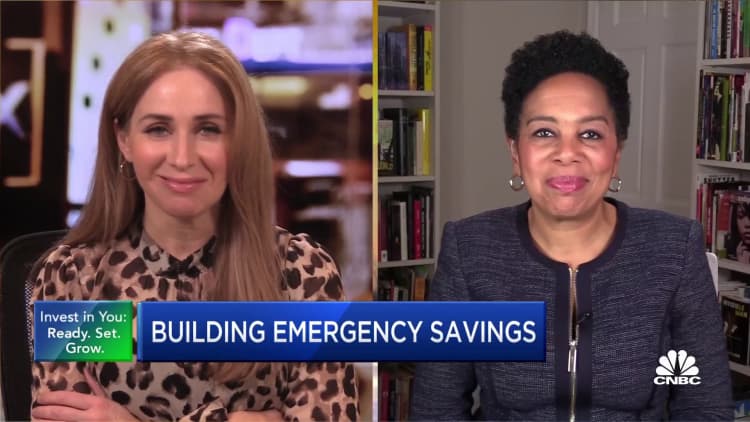Thomas Barwick | Digitalvision | Getty Images
Many families struggle to come up with the cash when faced with an unexpected $400 expense.
That lack of emergency savings may force them to borrow money at high interest rates to pay for the surprise expense, putting their financial security at risk.
Now Congress has a window to address that issue by paving the way for new emergency savings plans in the lame duck session.
Three emergency savings proposals may be included in a legislative package known as Secure 2.0, which is set to amplify changes to the retirement system brought by the Secure Act in 2019.
“We’re on the cusp of a significant shift in how people save for emergencies in this country, thanks to public policy and private sector innovation,” said Shai Akabas, director of economic policy at the Bipartisan Policy Center, during a recent web panel hosted by the Washington, D.C., think tank.
More from Personal Finance:
Reasons to say ‘no’ to a store credit card this holiday shopping season
How to score a charitable tax break on Giving Tuesday
Inflation boosts U.S. household spending by $433 a month
The panel discussion coincided with an open letter from the Bipartisan Policy Center Action with 40 organizations to Senate Majority Leader Chuck Schumer, D-N.Y., and Minority Leader Mitch McConnell, R-Ky., as well as House Speaker Nancy Pelosi, D-Calif., and Minority Leader Kevin McCarthy, R-Calif.
The letter called for the inclusion of three bills that would amplify emergency savings in the pending retirement package.
“We firmly believe emergency savings policy aligns with the goals of the U.S. retirement system and will help boost financial resiliency for American households,” they wrote.
Why emergency savings falls short
Anti-eviction banners are displayed on a rent-controlled building in Washington, D.C., on Aug. 9, 2020.
Eric Baradat | AFP | Getty Images
The Covid-19 pandemic was a stress test for many Americans’ finances.
As many parts of the economy shut down, many individuals and families found their incomes were reduced or eliminated altogether.
The federal government stepped in and sent unprecedented amounts of aid through three rounds of stimulus checks, enhanced federal unemployment benefits, direct monthly child tax credit payments to parents and other policies.
Yet the pandemic still led some workers to withdraw funds from their 401(k) or other retirement savings accounts, putting their long-term financial futures at risk.

“As people face that crisis, you need that liquid savings to protect your long-term investments and make sure you have a secure retirement and build wealth,” Tim Shaw, associate director of policy at the Aspen Financial Security Program, said during the Bipartisan Policy Center panel.
Covid relief measures helped push the share of families who could cover an unexpected $400 expense with cash or an equivalent method to 68% in 2021, a 4-percentage point increase from 2020. It also marks the highest level since the Federal Reserve began the survey in 2013.
Still, 1 in 3 households would need to borrow money to cover a $400 emergency, which is still “far too many,” Shaw noted.
How 3 proposals may encourage savings
Image Source | Getty Images
Advocates are hoping three proposals that could help encourage emergency savings will be included in Secure 2.0.
That includes two bills proposed by Sens. Cory Booker, D-N.J., and Todd Young, R-Ind., as well as a third created by Sens. James Lankford, R-Okla., and Michael Bennet, D-Colorado.
One proposal from Booker and Young would enable employers to provide emergency savings accounts to workers in addition to their retirement savings accounts. Employees would be able to set aside up to $2,500 automatically that they could access at any time in case of an emergency.
The second proposal from Booker and Young would allow for separate standalone plans outside of retirement accounts, which would be “really important” for employees who don’t currently have retirement plans through their employer, Akabas noted.
A third, the Lankford-Bennet plan, would allow workers to take out up to $1,000 from their retirement accounts penalty-free in case of an emergency. Those withdrawals would only be allowed once per year; additional contributions would be required before making another withdrawal.
Chantel Sheaks, executive director of retirement policy at the U.S. Chamber of Commerce, said she has “fingers crossed” that all three proposals will make it into Secure 2.0 and that the legislation will pass.
“From an employer’s viewpoint, we need choice,” Sheaks said.
What may work for one employer may not work for another, she noted. The three proposals would allow for more options, including possibly encouraging employers who do not current have retirement plans to think about adopting them, Sheaks said.
Moreover, because hardship withdrawals can reduce workers’ retirement security, these emergency savings options can help prevent those stumbling blocks to building wealth.
“People have emergency needs today, and we can’t forget about those emergency needs,” Sheaks said. “We need to find a way to balance today’s needs with tomorrow’s needs.”
 EU News Digest Latest News & Updates
EU News Digest Latest News & Updates



